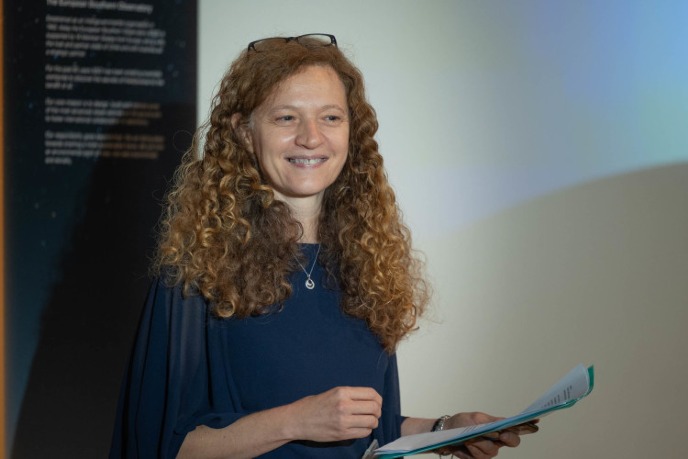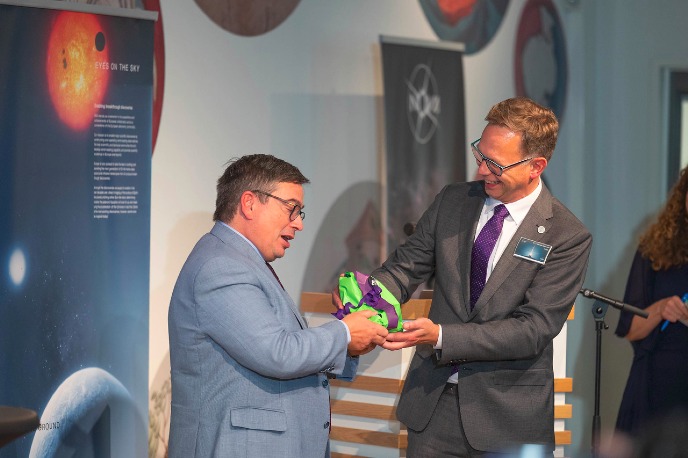Astronomy community celebrates 60 years of ESO
The Dutch astronomy community celebrated the 60th anniversary of the European Southern Observatory (ESO) and the collaboration with the Netherlands Research School for Astronomy (NOVA) in the areas of instrumentation, science, and social relevance on Monday 26 September at Museum Boerhaave in Leiden.
ESO was founded 60 years ago by a number of countries including the Netherlands, and now, the European intergovernmental organization for astronomy has 16 member states in the southern hemisphere. ESO builds and manages the most powerful and advanced telescopes in the north of Chile, which are being extensively used by European, and thus also Dutch astronomers for scientific research. The circumstances (dark, high, and dry) make the northern Chile an excellent area for astronomical research.
Eyes and ears
The gigantic telescopes, such as the Very Large Telescope on top of the Cerro Paranal mountain, the one being built on the Cerro Armazones mountain, and the large array of ALMA dishes located on the Chajnantor plateau have many instruments attached to them (the ‘eyes and ears’ of the telescope) for astronomical observations. The Netherlands has contributed to the development and construction of these instruments for all facilities. NOVA engineers and project managers are also working on developing technologically advanced and challenging instrumentation for the future Extremely Large Telescope, which is expected to go into operation later this decade. Dutch astronomers have already been able to make many fantastic discoveries using the facilities.
Over a hundred attendees from science, politics, and industry were present at the event, including minister Robbert Dijkgraaf from the Ministry of Education, Culture, and Science, Linda Tacconi, ESO Council's president, Xavier Barcons, director general of ESO, Tim de Zeeuw and Harry van der Laan, former ESO directors. Rector Magnificus Cisca Wijmenga and FSE dean Joost Frenken were also present on behalf of the University of Groningen.
Alive and kicking
Scientists and engineers from ESO and the NOVA institutes at the universities of Amsterdam, Groningen, Nijmegen, and Leiden contributed to the symposium, which was chaired by Amina Helmi, scientific director of NOVA, Michiel Rodenhuis, executive director, and Ewine van Dishoeck, NOVA ambassador.
Michiel Rodenhuis gave Xavier Barcons a present for the 60th anniversary of ESO: a specially engraved version of one of the first parts of MICADO, one of the first-generation instruments on ESO’s Extremely Large Telescope which is being built in northern Chile. The part was designed for the mounting of the complex cryogenic filter wheel of MICADO, for which NOVA is responsible. Amina Helmi said that this meeting showed how alive and kicking ESO is, the observatory that is already renowned in the field of astronomy.
The day ended with an interview with minister Dijkgraaf conducted by Ewine van Dishoeck in which the importance of structural cooperation between the Dutch astronomy community and ESO in the areas of optic/infra-red and submillimetre astronomy was emphasized.


| Last modified: | 11 October 2022 4.55 p.m. |
More news
-
24 March 2025
UG 28th in World's Most International Universities 2025 rankings
The University of Groningen has been ranked 28th in the World's Most International Universities 2025 by Times Higher Education. With this, the UG leaves behind institutions such as MIT and Harvard. The 28th place marks an increase of five places: in...
-
05 March 2025
Women in Science
The UG celebrates International Women’s Day with a special photo series: Women in Science.
-
16 December 2024
Jouke de Vries: ‘The University will have to be flexible’
2024 was a festive year for the University of Groningen. In this podcast, Jouke de Vries, the chair of the Executive Board, looks back.
